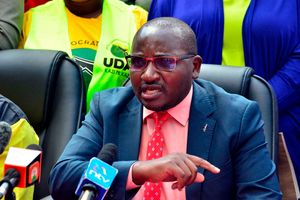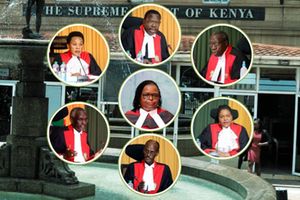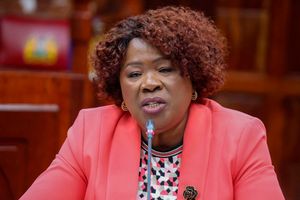Before Google maps, there was Gladys West, the woman who shaped modern GPS technology

Mathematician Gladys West. She helped invent GPS.
What you need to know:
- In 1930s segregated Virginia, Gladys defied societal limitations placed on Black women by excelling in mathematics and becoming one of the few Black employees at the Naval Surface Warfare Centre.
- Her mathematical genius led her to create the first precise mathematical model of Earth's gravitational field - a breakthrough that became the foundation for the Global Positioning System (GPS).
In the 1930s, in segregated Sutherland town south of Richmond, Virginia, USA, there were two occupational options for black women. They could either work for penurious pay on local sharecropping manual farms, or acquire tiring jobs at one of the tobacco processing plants. As she grew up, Gladys Mae Brown's mathematical enthusiasm emboldened her ambition to create a divergent pathway from the black.
She prided herself as the person who defied convention and graduated in 1948 as a valedictorian at Dinwiddie Training School for coloureds. As a consequence of her academic distinction, Gladys received a full scholarship to attend Virginia State University, a historically black college and university, where she majored in mathematics, a course that was still exclusive for men. Her rebelliousness prompted her to apply for various positions after graduation, but her applications were rejected immediately when it was discovered she was black. She eventually accepted a temporary role as a high school mathematics teacher in Martinsville, Virginia.
In the summer of 1955, IBM delivered the Naval Ordnance Research Calculator (Norc) to the Naval Surface Warfare Centre (NSWC). Norc was a $2.5 million Columbia University custom-built, room-sized device – the most powerful computer ever assembled at the time. Norc required savvy human interpretation to operate, and the comprehension of a competent individual to input and format the data. There were no computer science majors to hire. Therefore, the Navy scouted for potential employees with a background in mathematics and settled for Gladys. She joined the Naval Dahlgren division and took up the position of a computer programmer in 1956. The NSWC was operated by the US Navy and supplied technological operations, engineering services and products required to equip and meticulously support the Naval fleet while gratifying the duties of war fighters.
Gladys also got the position of project manager for processing systems at Dahlgren, which had the largest fleet concentration in the Navy. She became the second black woman ever employed in the division and one of only four black employees at the entire NSWC. One of those black men was Ira West, whom she wedded in 1957.
While studying for a Master of Public Administration at the University of Oklahoma, Gladys employed her ingenious ability of optimising algorithms and quickly tracking down viruses in the Norc computer. The initial satellite navigational system used by the Navy was known as Transit and was propagated to calculate accurate location information on Polaris ballistic missile submarines that the US Navy was deploying. Transit used five space satellites that could generate a location, which was accurate within 150 metres but took about an hour to obtain a result.
The military began plans of advancing a more sophisticated system, which could produce location data instantaneously. Inhibition was caused by the fact that the Earth’s gravitational fields are wildly inconsistent, depending on one’s specific position. This is because the Earth doesn't possess a perfect sphere and its gravitational fields are distorted by features such as tides, ocean trenches and mountain ranges that inhibited Transit from working accurately.
Gladys began working on experimental satellite altimeter systems (Seasat) in the 1960s. These were designed to measure an accurate shape of the Earth. In the 1970s, she was promoted to project lead of the Seasat programme and deployed a three dimensional radar technology to detect oceanographic conditions, including wind, water, temperature and ice formations.
In the early 1980s, Gladys led a five-member team that was programming the IBM 7030 computer, popularly known as Stretch. She customised it to calculate a precise account of what is technically known as a geoid, a mathematical description of the Earth's gravitational calculation.
She created the first irrefutable account of the geoid, and wrote a handbook for future technicians, describing the best techniques to create more precise models. It delivered increasingly refined and pristine calculations of the Earth's gravitational fields that coordinated a pinpoint Global Positioning System (GPS) on targeted objects, with instant results and remarkable accuracy.
It was new and exciting and there was an incredible amount of data. Gladys states in her memoir, It Began with a Dream, that her work during this period appeared inconsequential, and its relevance was only used by oceanographers and nuclear submarine navigators. The precision of the geoid was still classified and the information was exclusively used in secrecy by the US military.

Gladys West's memoir, It Began with a Dream.
However, on September 1, 1983, a Korean Airlines 747 en route to Seoul from New York City was mistakenly shot down by Russian fighter planes that used land-based beacons, which accidentally caused the plane to drift into Russian airspace. This calamity compelled then US President Ronald Reagan's authorisation of satellite navigation for private sector access. This instigated the global reverberation and adoption of Gladys's GPS by the automobile industry in the 1990s. Apple emulated them in 2008 by adding a GPS receiver to its iPhone 3G, authorising efficient tracking apps, individual navigation and exact location determination.
The writer is a novelist, Big Brother Africa 2 Kenyan representative and founder of Jeff's Fitness Centre (@jeffbigbrother).




